| 1 | The world’s longest venomous snake |
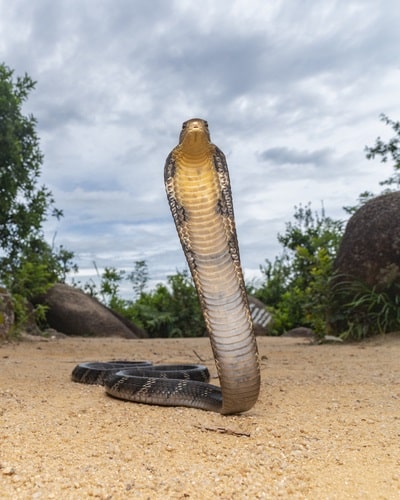
Alongside the black mamba and boa constrictor, no snake has embedded itself in the public imagination quite like the king cobra. Its deadly venom and startling neck flare are well known, yet there’s even more to this southeast Asian snake than first meets the eye.
Firstly, this is the official longest venomous snake in the world, with an average of 3-4.5 metres, with males exceeding females. Black mambas rank in second, while the South American bushmaster ranks third.
Secondly, king cobras have a highly specialised diet: other snakes. They’re king for a reason, as no other cobra is willing to challenge them. At least 95% of its diet consists of fellow snakes, with only a handful of confirmed exceptions in the wild, such as water monitors and common Indian monitors, which are essentially backups.
In India, their absolute favourite prey is the ubiquitous oriental ratsnake (Ptyas mucosa). They also love Malabar pitvipers, and occasionally eat hump-nosed pitvipers. The list of confirmed snakes they eat is endless: Indian wolf snakes, black-banded keelbacks, small Indian pythons, sunbeam snakes.
King cobras also boast the largest snake prey ever consumed by a fellow snake. As reported in 1947, a 365.8cm king cobra attempted to eat 279.4cm python. This report had many interesting facts, including one king cobra which ate 82 snakes over the course of a single winter, and another which swallowed 13.7 metres of snakes when tracked from July to March.
| 2 | Diet: 95% other snakes |
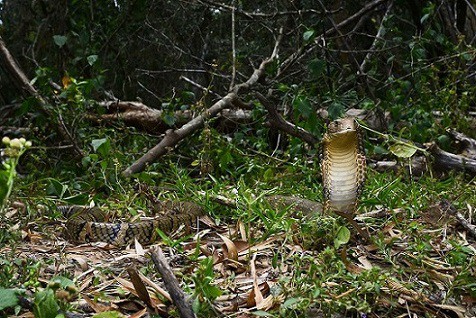
Despite their name, and signature neck flare, king cobras are not technically a cobra. They’re the sole member of the Ophiophagus genus, while true cobras belong to Naja, with 38 members. Ophiophagous is the technical term for snake-eating, which scientists used as inspiration for the Latin name.
King cobras have a huge territory in southeast Asia. The core encompasses Thailand, Myanmar, Cambodia, Vietnam and Bangladesh. The westernmost zones lie in extreme northern India and Nepal along the Himalayan foothills. There’s also a strong colony in the western Ghats mountains of southern India. To the south, they inhabit all of Malaysia, Singapore, and most of Indonesia, excluding Papua and various small islands.
Despite their massive empire, king cobras aren’t especially common within that range. They’re naturally spread out, and you’re more likely to spot one lone Ophiophagus hannah prowling a forest than a whole gang sitting by a campfire. Wherever they coexist with true cobras, they’re much less common – monocled cobras outnumber them in Thailand, and Indian cobras in India.
| 3 | The longest king cobra on record |
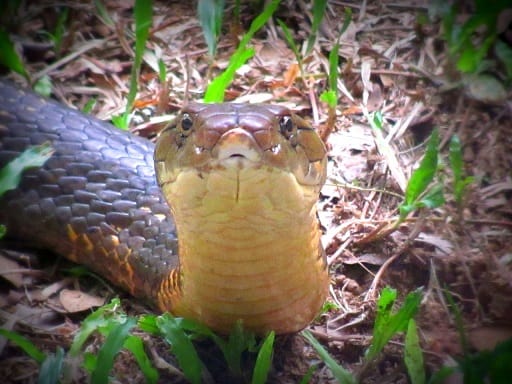
Though not the thickest venomous snake worldwide (east diamondbacks beat them), king cobras dominate the competition for length, with a confirmed all time record of 5.85 metres. This dwarfs the largest member of the true cobra family, the forest cobra (Naja melanoleuca), at a record of 3.2 metres.
Another brute measured 5.54 metres, and was collected in Negeri Sembilan, Malaysian peninsular in 1937, and later displayed proudly in London Zoo. This grew to 5.71 metres by 1939, but had to be put down upon the outbreak of World War 2, to prevent it from escaping and roaming the streets of London, in case German bombers damaged the building. Most aren’t that huge, yet still hefty. A 2022 survey examined 21 adult king cobras in Thailand, and found a range of 2 to 4 metres long.
Newborns are longer than many adult snakes. In one sample of 27 from India, the newborn range was 46.7–55.9cm, with a weight of 17-25 grams. This exceeds an adult ringneck snake (USA) at 30cm, and an adult shield-tail snake (India) at 40cm.
King cobras also transform in pattern with age. As youths, they have sharply contrasting black and white bands, occasionally yellow instead. These fade into a more consistent olive pattern with age, with faint bands still just visible.
| 4 | Builds nests like a bird |
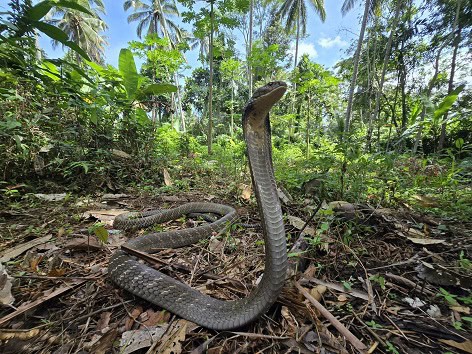
One of the king cobra’s rarest tendencies within the snake kingdom is building a nest for its eggs. In fact, they’re the only confirmed snake species to build a nest, and definitely no member of the true cobra family does. Mother king cobras select areas within forests, usually with an incline to allow water drainage. They gather material ranging from chir pine leaves to bamboo leaves to Baanj oak leaves. They construct a nest over 50cm tall and 1 metre wide, which has 3 distinct sections: an outer surface layer of material, the inner material, which is like the bricks, and then an inner egg chamber, where 14-35 eggs are laid.
The most eggs a king cobra has ever laid was 53, in captivity in Brownsville Zoo, Texas. After laying her eggs, the mother then guards this nest, by sitting on top, and coiling up. The eggs are stashed away, but if any overambitious predators arrive, greedily rearing their talons up, the mother king cobra will fight back.
In a study from Nainital, India, the mother stayed with her nest for 3 weeks after laying, then departed. The eggs hatched 100 days after being laid. Even without the defensive mother, they were well shielded by the elements, by a protective structure almost the size of a termite mound.
| 5 | Not a true cobra |
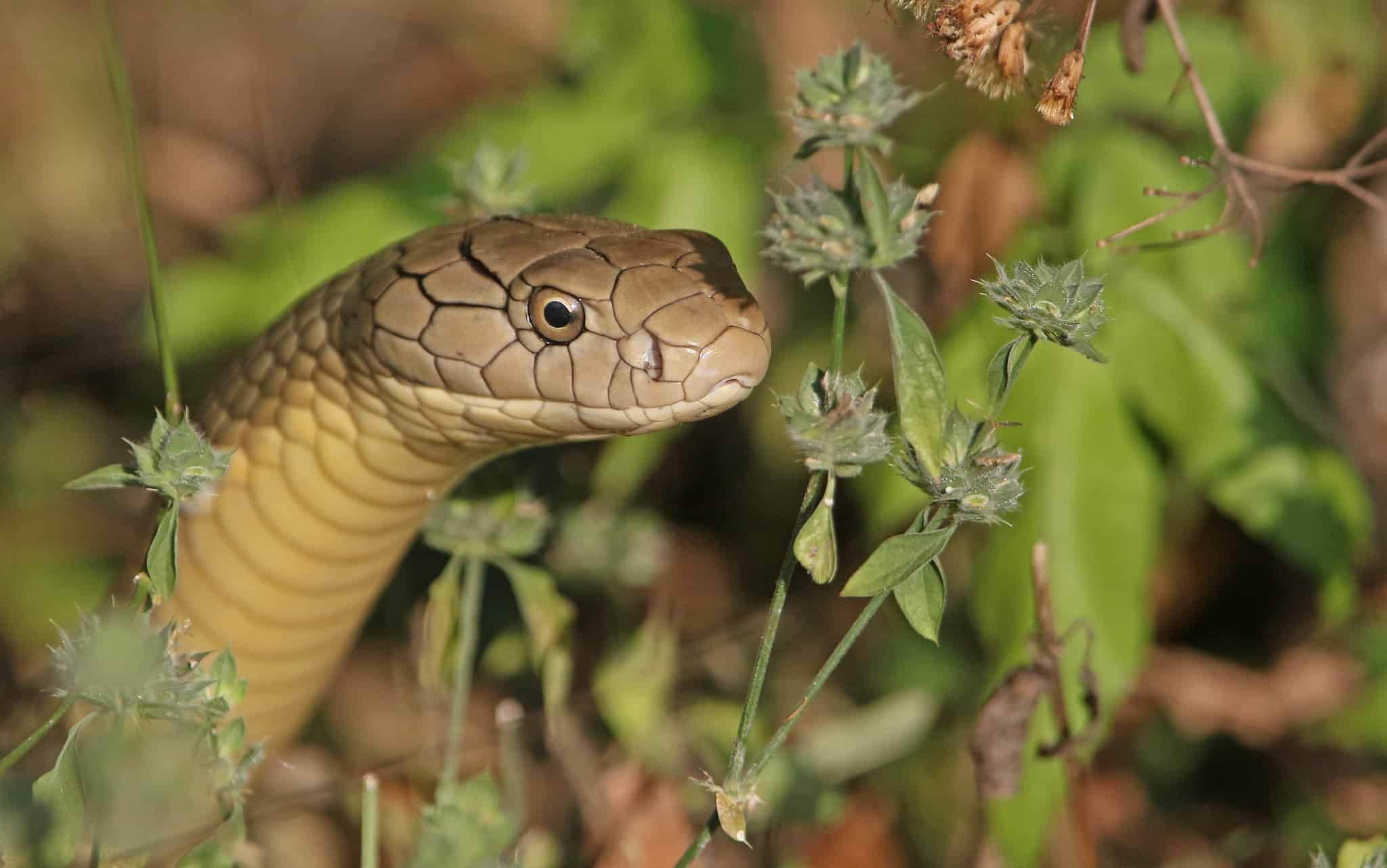
Not only are king cobras not a true cobra, they’re not even their next closest relative. It’s estimated that king cobras, or their ancestor anyway, split off from the Naja genus of true cobras 29 million years ago. King cobras split much more recently from the African mambas, AKA the black mamba and green mamba, from which they diverged 22 million years ago. Then that’s it, as far as we know. The mambas are the king cobra’s closest living relatives.
Since then, it’s been a relatively isolated path. But in 2022, a study revealed that king cobras have deep DNA chasms between them, based on location. It found 4 strong genetic groups, or clades: 1) Luzon island, Philippines, 2) Indonesia, Malaysia, remaining Philippines, 3) the largest swathe of the range, including Myanmar, Thailand, Vietnam, northern India, etc, and 4) the Indian western Ghats. It was estimated that these clades diverged 3.5-5 million years ago. It’s possible that these represent secret species, and that the king cobra may be broken up in the years to come.
As far as cobra clones go, the rinkhals diverged from true cobras much more recently, around 17-18 million years ago. Black desert cobras and cape coral snakes also diverged from the true cobras 22.5 MYA. King cobras are on a much more distant branch of the evolutionary tree. For comparison, it’s estimated that humans diverged from chimpanzees 6.5-9.3 MYA.
| 6 | Shelters in dark burrows |
King cobras are mainly a forest species, particularly tropical evergreen forests. They’re reasonably flexible, straying to villages and plantations, but less flexible than true cobras, and will disappear if an area is heavily deforested. One of their main habitat requirements is annual precipitation above 1500 mm. Below this, king cobras will suddenly disappear. They avoid arid zones like the plague, unlike the Indian cobra.
A 2013 study revealed that king cobras particularly correlate with logs close to streams. In the Western Ghats mountains of India, they regularly sheltered in dark mammals burrows too, even fleeing into them when scientists approached. They seemed to instinctively sniff out these burrow shelters. The king cobras were strongly diurnal, as 87% of observations were from 10:00-18:00.
You’d think that king cobras would be fully mapped out by now, they’re so famous. Yet new locations are still being added, such as in 2017, when the king cobra was officially observed in Pakistan for the first time ever. It was a 5.1-5.5 metre monster as well, with a black colour, observed on a road in Bagh district. In 2022, scientists found a king cobra on Panay Island, Philippines, which extended its known territory by over 100km.
| 7 | Resistant to pitviper venom |
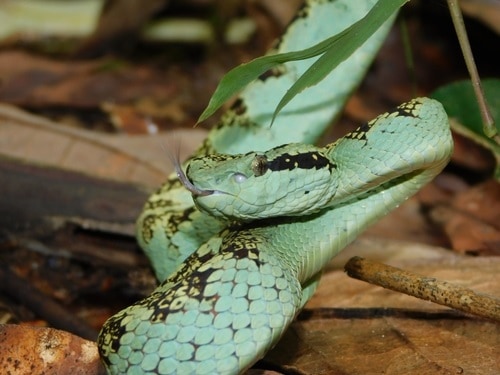
Like the true cobras, Ophiophagus hannah is an active forager, instead of an ambusher. Their relentless quest for food takes them far and wide. A typical home range encompasses 6-8 km², and king cobras typically move 200 metres in an average day. The record was a king cobra which somehow covered 1.5 kilometres in 10 minutes.
A study from India’s western Ghats found a particular addiction to one viper: the Malabar pitviper (pictured above), which was recorded 24 times, versus twice for the hump-nosed pitviper. One king cobra was tracked, which roamed evergreen forests endlessly, flecking its tongue at random objects. When the snake found a scent trail, its tongue flecking rapidly accelerated, and they followed a much more focussed and direct line. This usually brought them to a Malabar pitviper resting 2-15 metres high on a branch, which the king cobra cunningly attempted to scare into dropping to the ground, where they were easy to pick off.
The king cobra was bitten by pitvipers 9 times over the 3 month study. Once, it envenomated a large female Malabar pitviper, which in turn delivered a piercing bite to the king cobra’s head. The pitviper fled up a branch, while the king cobra froze, staying completely still. Its mouth hung open, and it didn’t even fleck its tongue. After 20 minutes, the pitviper succumbed to the venom and dropped 6 metres to the forest floor, yet the king cobra still didn’t react.
Finally, after 30 minutes, the king cobra reactivated. King cobras seem to have venom resistance, but with a delay factor while they metabolise the toxins. Another confirmed venomous prey of king cobras is the Nepal pitviper.
| 8 | Clamps down on victims’ arms |
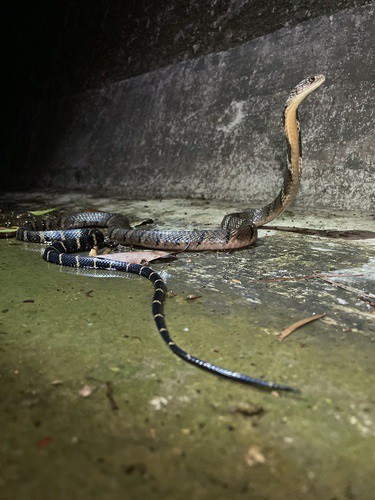
It’s not surprising that king cobras are a severely dangerous snake. It’s estimated that the bite can kill humans within 30 minutes. The LD50 toxicity score is 1.2mg, less deadly than black mamba (0.05mg), but well outstripping a cottonmouth (2.04mg). It’s the venom yield that makes king cobras a nightmare. 500mg per bite is normal, and over 1000mg is possible. It’s not that they produce disproportionately large amounts of venom. They’re simply so huge that the quantity of venom rises in close correlation.
Like other elapids, the family including coral snakes, sea snakes and cobras, king cobras have control over their own venom glands. They also have a disturbing tendency to clamp down on the victim’s limb, and continue to inject venom, pumping every higher quantities into their bloodstream. Other species like Indian cobras favour a bite then immediately release strategy.
That said, king cobras bite people relatively rarely. In the 1930s and 40s, there was huge debate in herpetological circles. Some considered them to be a terror that launched unprovoked attacks on humans, while the opposing argument was the king cobras only attack when seriously provoked. The latter turned out to be true. King cobras cause a far smaller proportion of bites in Thailand compared to monocled cobras, the resident true cobra.
| 9 | Severely neurotoxic |
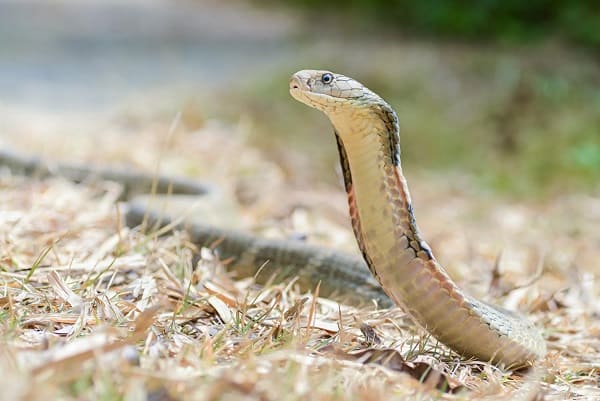
King cobra venom is rich in neurotoxins, particularly alpha-neurotoxins, which contribute most of their lethal qualities. Unlike true cobras, there’s an abundance of snake venom metalloproteinases (SVMPs), which contribute below 1% in true cobras, but up to 24.4% in king cobras.
A detailed case report involved a 22 year reptile shop worker from the UK. He sustained a bite to his left index finger, and arrived at hospital 20 minutes later. He complained of dizziness, and a classic neurotoxic symptoms arrived at 30 minutes post bite: ptosis, AKA drooping eyelids. The victim was soon struggling to breathe, and unable to swallow his saliva. Neurotoxicity was advancing, so doctors wasted no time and artificially incubated him. 2 hours post arrival, he was transferred to intensive care.
It took 6 hours for the specialised king cobra antivenom to arrive from London, in a hefty dose of 20 vials. Doctors began administration, but rashes appeared on the victim’s chest and arms, hinting at an allergic reaction. They slowed the infusion rate, and finally administered all the antivenom by 9.5 hours. By 17 hours post bite, the patient had miraculously recovered – he was able to lift his head, his eyelids were no longer drooping and his limbs had regained full function.
King cobra bites can paralyse your body, but antivenom seems to work well, possibly because their neurotoxins are in post-synaptic form – pre-synaptic are far harder to treat.
| 10 | Rarely causes haemorrhaging |
Another study mentioned 3 cases from Myanmar, each suffered during a snake dance in Rangoon Zoological Gardens. One luckily suffered no effects, a dry bite. Another experienced only local symptoms, but the final patient had severe symptoms, requiring mechanical ventilation for 64.5 hours, with massive swelling of the limb.
Raw king cobra venom is yellow and viscous. Amputations are common following king cobra bites, and farm workers are often left with injuries that reduce their performance. There’s one redeeming feature of king cobra venom: that haemorrhaging is unheard of in humans. Weirdly though, it does affect hares and rabbits. This tends to be the speciality of vipers like rattlesnakes.
Mammals aren’t even on the menu for king cobras, let alone humans. It’s clear that their lethal venom evolved solely to scare off predators (which they file humans under). King cobras rarely get their comeuppance, but they have a few natural predators. One is the Malaysian blue coral snake, which averages at 140cm, way too small to prey on adult king cobras, but this species has a huge taste for baby king cobras.
